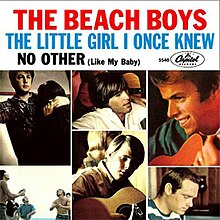The Little Girl I Once Knew
| "The Little Girl I Once Knew" | ||||
|---|---|---|---|---|
 | ||||
| Single by the Beach Boys | ||||
| B-side | "There's No Other (Like My Baby)" | |||
| Released | November 22, 1965 | |||
| Recorded | October 13–24, 1965 | |||
| Studio | Western, Hollywood | |||
| Genre | Avant-pop[1] | |||
| Length | 2:35 | |||
| Label | Capitol | |||
| Songwriter(s) | Brian Wilson | |||
| Producer(s) | Brian Wilson | |||
| The Beach Boys singles chronology | ||||
| ||||
| Music video | ||||
| "The Little Girl I Once Knew" on YouTube | ||||
| Audio sample | ||||
| ||||
"The Little Girl I Once Knew" is a song by the American rock band the Beach Boys that was recorded during the early sessions for their 1966 album Pet Sounds. Written by Brian Wilson, it was released as a non-album single in November 1965.[2]
Background and lyrics[]
Lyrically, "The Little Girl I Once Knew" follows familiar territory as the Beach Boys' 1964 outtake "All Dressed Up for School", telling the story of a guy who reacquaints with a girl from his past who has now grown up and catches his eye.[3] According to Mark Dillon, some speculate that the song was written about Brian's then-wife Marilyn Wilson.[3] Mike Love reportedly had a hand in the lyrics, although his 1992 lawsuit for officially recognized writing contributions failed to include "The Little Girl I Once Knew".[3]
Recording and composition[]
"The Little Girl I Once Knew" was recorded shortly after Brian Wilson completed Beach Boys' Party! in between sessions for the Pet Sounds tracks "Sloop John B" and "You Still Believe in Me".[4] It was initially labelled "Carol K" on its session tape box, a reference to the song's bassist, Carol Kaye.[3] The track has drawn comparisons with the work of contemporary Burt Bacharach, whom Wilson admired.[5]
The song is unusual in that it uses stop–start melody sections and a few dramatic periods of silence lasting several seconds each.[6] Dillon writes that the verses are "low-key" and hard-shift into a "blaring chorus" that "foreshadows the Smile track 'Cabin Essence'".[3] In a 2007 interview, Wilson stated,
That is my very favorite introduction in a song in my whole life. It kills me every time. It might have been the first time the music stopped and started again on a record. I wrote the intro at the studio before we cut the thing. And, [session musician] Larry Knechtel, it was his idea to keep the music rolling. We tried one, and then I put a second guitar overdub on top of the other guitar. And the rest of it was history. We were doing stereo but I could only hear the mono and I always put the vocals up front in the mix. Mixing in mono is good for my left ear. My right ear is broke, done and over with.[7]
Wilson was dissatisfied with his vocal performance, calling it "too effeminate".[7] In 1995, Wilson expressed, "It was a fine song, except the intro is the only good part of it, and the rest didn't sound so good. I thought the song in itself sucked. I didn't like the harmonies, I thought they were sour and off-key."[8] In 2014, he said that the song "should've" gotten more attention than it did.[9]
Release and reception[]
It was released in November 1965 as a single 45 rpm, backed by "There's No Other (Like My Baby)", and reached #15 on the Cash Box chart and #20 on Billboard.[citation needed] Since radio stations preferred to avoid dead air time, the song was poorly received by them.[6][5] Just after its release, John Lennon gave it a favorable review:
This is the greatest! Turn it up, turn it right up. It's GOT to be a hit. It's the greatest record I've heard for weeks. It's fantastic. I hope it will be a hit. It's all Brian Wilson. He just uses the voices as instruments. He never tours or anything. He just sits at home thinking up fantastic arrangements out of his head. Doesn't even read music. You keep waiting for the fabulous breaks. Great arrangement. It goes on and on with all different things. I hope it's a hit so I can hear it all the time.[3][10]
Retrospectively, AllMusic reviewer Matthew Greenwald called the song "a virtual link between the slightly progressive work on songs such as 'California Girls' and the then-quantum leap taken by Wilson on Pet Sounds and 'Good Vibrations'".[6]
Personnel[]
According to Mark Dillon,[3] except where noted:
- The Beach Boys
- Mike Love – backing vocals
- Brian Wilson – lead vocals[5]
- Carl Wilson – lead vocals
- Al Jardine – lead vocals[citation needed]
- Bruce Johnston – backing vocals[citation needed]
- Session musicians
- Frank Capp – percussion
- Carol Kaye – bass
- Don Randi – organ
Charts[]
Weekly charts[]
References[]
External links[] |
- The Beach Boys songs
- 1965 singles
- Songs written by Brian Wilson
- Song recordings produced by Brian Wilson
- Capitol Records singles
- 1965 songs
- Song recordings with Wall of Sound arrangements